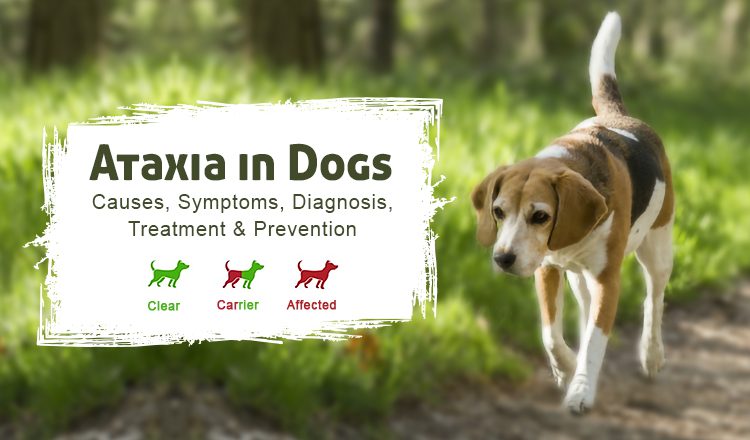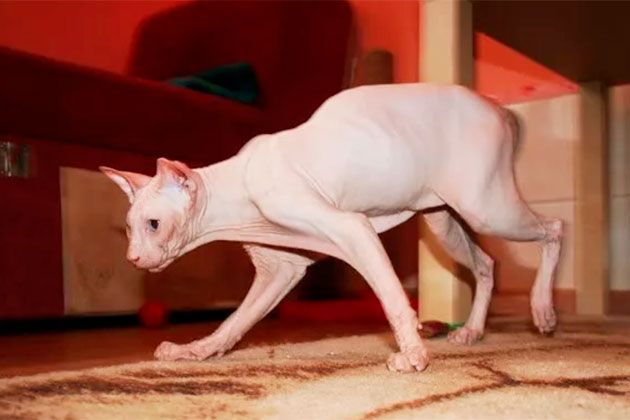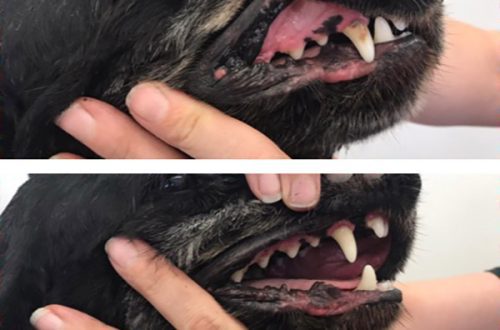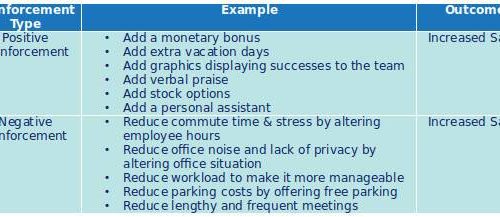
Ataxia in dogs and cats

Today, neurological disorders in dogs and cats are far from uncommon, and ataxia is a fairly common disorder. We will find out why it appears and whether it is possible to help an animal with ataxia.
Contents
What is ataxia?
Ataxia is a pathological condition that occurs when the cerebellum, the brain structures responsible for the coordination of movements and orientation of the animal in space, is damaged. It manifests itself in impaired coordination and individual movements in animals due to impaired functioning of the nervous system. Ataxia can be congenital or acquired. The most predisposed to the disease are Staffordshire Terriers, Scottish Terriers, Scottish Setters, Cocker Spaniels, Scottish, British, Siamese cats, sphinxes. No relationship was found with age and gender.
Types of ataxia
Cerebellar
It occurs as a result of damage to the cerebellum during intrauterine development, symptoms can be noticed immediately after birth, they become more clearly visible when the animal begins to actively move and learn to walk. Can be static and dynamic. Static is characterized by weakening of the muscles of the body, the gait is shaky and loose, it is difficult for the animal to coordinate movements and maintain a certain posture. Dynamic manifests itself during movement, greatly modifying the gait – it becomes impetuous, jumping, sweeping, awkward, with the whole or only the back of the body falling on its side, and the movement of the front and hind legs is uncoordinated. The cerebellar ataxia differs from other types of ataxia in the presence of nystagmus – involuntary trembling of the eyes, trembling of the head when the animal is focused on something. Degrees of ataxia:
- Mild ataxia: slight leaning, swaying or tremor of the head and limbs, a slightly uneven gait on widely spaced legs and occasional leaning to one side, turns with little slowness, jumps awkwardly.
- Moderate: Tilt or tremor of the head, limbs, and entire torso, aggravated by trying to focus on an object and eating and drinking, the animal does not get into a bowl of food and water, food may fall out of the mouth, bump into objects, almost cannot go down the stairs and jump, turns are difficult, while walking in a straight line is easier. When walking, it can fall sideways, the paws are widely spaced, bent “mechanically” and with a high rise.
- Severe: the animal cannot stand up, lies down, raises its head with difficulty, there may be pronounced tremor and nystagmus, it also cannot go to the toilet in a certain place on its own, while it can endure until they take it to the tray or take it out into the street, and goes to the toilet while holding. They also cannot approach the bowl, and they will eat and drink when they are brought to the bowl, the food is most often not chewed, but swallowed whole. Cats may be able to move around by crawling and clinging to the carpet with their claws.
Cerebellar ataxia is not treated, but does not progress with age, mental abilities do not suffer, the animal does not experience pain, and skills improve, and with mild and moderate ataxia, by about a year the animal adapts to play, eat, and move around.
sensitive
Associated with spinal cord injury. The animal cannot control the movement of the limbs, bend and unbend them at will, and determine the direction of movement. The movements are painful, the animal tries to move as little as possible. In a severe case, movement is impossible at all. Treatment is possible and can be successful with early diagnosis and initiation of treatment.
vestibular
Occurs with damage to the structures of the inner ear, otitis, tumors of the brain stem. The animal hardly stands, can walk in a circle, lean on objects when walking, fall towards the affected side. The head is tilted or thrown back also to the affected side. The body can sway, the animal moves with its paws wide apart. Nystagmus is common. Experiencing a headache, or pain in the ear, the animal can sit for a long time with its forehead against a wall or corner.
Causes of ataxia
- Trauma to the brain or spinal cord
- Degenerative changes in the brain
- Tumor process in the brain, spinal cord, hearing organs
- Infectious diseases affecting the central nervous system and brain. Ataxia can develop in offspring if the mother has suffered an infectious disease during pregnancy, such as feline panleukopenia
- Inflammatory diseases of the brain and spinal cord
- Poisoning with toxic substances, household chemicals, drug overdose
- Deficiency of B vitamins
- Low levels of minerals, such as potassium or calcium in the blood
- Hypoglycaemia
- Vestibular ataxia can occur with otitis media and inner ear, inflammation of the nerves of the head, brain tumors
- Coordination disorders can be idiopathic, that is, for an unexplained cause
Symptoms
- Twitching of the head, limbs, or body
- Rapid movement of icons in a horizontal or vertical direction (nystagmus)
- Tilt or shake the head
- Manege movements in a large or small circle
- Wide limb stance
- Loss of coordination in movement
- Unsteady gait, moving paws
- High rise of straight forelegs when walking
- Shackled “mechanical” movements
- Falls to the side, the whole body or just the back
- Difficulty getting up from the floor
- Difficulty getting into the bowl, eating and drinking
- Pain in the spine, neck
- Sensory disturbance
- Violation of reaction and reflexes
Usually with ataxia, a combination of several signs is observed.
Diagnostics
An animal with suspected ataxia requires complex diagnostics. A simple inspection will not be enough. The doctor performs a special neurological examination, which includes sensitivity, proprioception, and other tests. Based on preliminary results, the doctor may prescribe additional diagnostics:
- Biochemical and general clinical blood test to exclude systemic diseases, poisoning
- X-ray
- Ultrasound, CT or MRI for suspected tumors
- Analysis of cerebrospinal fluid to exclude infections and inflammatory processes
- Otoscopy, if perforation of the eardrum, otitis media or inner ear are suspected.
Treatment of ataxia
Treatment for ataxia depends on the underlying cause of the disease. It happens that the situation is quite easily corrected, for example, with a lack of calcium, potassium, glucose or thiamine, it is enough to make up for the deficiency of these substances to significantly improve the condition. However, it is worth finding out the cause that caused the problem. In the case of ataxia caused by otitis media, it may be necessary to discontinue ear drops because some are ototoxic, such as chlorhexidine, metronidazole, and aminoglycoside antibiotics. Therapy may include washing the ears, the appointment of systemic antimicrobial, anti-inflammatory and antifungal drugs. Surgical intervention for neoplasms, herniated intervertebral discs. When diagnosing neoplasms in the brain, treatment is only surgical and is carried out only if the location of the formation is operable. The veterinarian may prescribe diuretics, Glycine, Cerebrolysin, vitamin complexes, depending on the type and cause of ataxia. The situation is more complicated in the case of congenital or genetically determined ataxia. In these cases, it is difficult for the animal to fully restore normal functioning, especially with severe ataxia. But physiotherapy rehabilitation will help to achieve a positive effect. It is possible to install carpeted ramps, non-slip bowls and beds in the house, dogs can wear support harnesses or strollers for walks with moderate ataxia and frequent falls to avoid injury. With mild to moderate congenital ataxia, the animal’s skills improve by the year, and they can live a relatively normal full life.
Prevention of ataxia
Acquire puppies and kittens from trusted breeders, from vaccinated parents who have passed genetic tests for ataxia. Carefully monitor the health of the animal, vaccinate according to the plan, pay attention to changes in appearance, behavior, contact the veterinarian in a timely manner.





